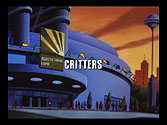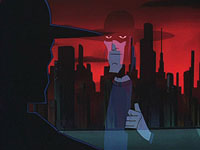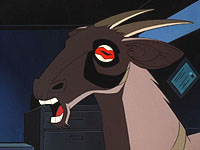|
||
|
| Credits | Cast | |
Story by Steve Gerber Written by Joe R. Lansdale Directed by Dan Riba Music by Shirley Walker Animation by Koko/Dong Yang |
Kevin Conroy as Batman Mathew Valencia as Robin Tara Charendoff as Batgirl Bob Hastings as Commissioner Gordon Robert Constanzo as Bullock |
Peter Breck as Farmer Brown Dorian Harewood as Judge Phil Hayes as Sergeant Dina Sherman as Emmylou Jane Singer as Old Woman |
|
Even a second look will probably fail to impress; it’s too easy to leave in place the prejudices aroused by a first viewing. But search it receptively, actively, watchfully, and something else begins to come into focus. You might start by turning down the sound, or at least plugging your ears whenever a character opens his or her mouth. Then you might notice that, visually, this is one of the darkest TNBA episodes, full of apocalyptic reds and blacks. And not just in the skyline. The same color scheme dominates the mutant animals: a bull the color of a dried scab and carnivorous "chickens" whose feathers hang like black funeral crepe. (Everyone remembers the "bugs" without remembering that they barely have any screentime.) Darkness frames many of the scenes. As I say, watch the episode without listening to the characters—though you should let the dissonant, wailing score wash over you—and it would hardly occur that it is meant to be a bit of pop kitsch. Well then, if it's not "Adam West," is it supposed to be a "monster" movie? It has none of the scale of one. Some big animals get loose and do some damage, at the instigation of a criminal who just wants a truck full of money. Then there are the jokes and puns—both visual and verbal—that undercut the sense of serious danger. Of course, there is a sense that people could get hurt, but it's only the danger that comes from facing a wild animal, not a malevolent intelligence. The result is an odd sense of displaced but undispelled menace. Something is wrong or out of control, and yet nothing specifically stands out as a locus of danger. The threats are both familiar and unfamiliar, so that the viewer is unsure whether to take it seriously or not. The same indecision afflicts the characters, who react with a kind of wary incredulity; they can neither believe nor disbelieve what they are seeing. (That is also why they make uneasy jokes; what else are you going to say when you've just been run over by a cow except "We've just been run over by a cow"?) It’s the horror of watching the world, while still looking exactly as it did before, begin to behave in very strange ways. The situation is, to use a special word, "uncanny."
So too with the villains. The inane Farmer Brown and his hormone-stuffed daughter have no glint of the daemonic, as do Dr. Cuvier or his minions in the similar, genetically-inclined "Splicers." And yet the very banality of their motives (loot and revenge) and personality ("Always check your shoes and count the money") make them the more unnerving villains. The banal is by definition more common than the outre. This man could be your neighbor, which should not be a comforting thought. Your neighbor might not be in the business of manufacturing giant animals. Still, what might he be in the business of manufacturing? (It's only a cartoon. Still, we're talking about a grudge-nursing lunatic who causes high-tech havoc in a major metropolis: The frightening disparity between the savage but puerile mind and the awesome destruction it can unleash should have more resonance post-9/11 than it did in 1998.) "Critters" does to the viewer what its critters do to the characters—it purposefully confounds expectations and defies easy categorization. It works—if you will accept my late and belated claim that it does work—by deploying those clashing tones and inconsistent styles that its detractors complain about, and it does so with the aim of unsettling the mind and spirit. After all, in aesthetics and entertainment as in life, we like the world to come in nice, neat, dependable, predictable packages, and it upsets us when our expectations are thwarted. In doing so, the episode takes a daring line and challenges us to accept the uncomfortable premise that the world, both in fact and art, has no duty to conform to our prejudices. |
|
|
|
Related Episodes |
What Others Are Saying ... |
| Back to Cold Comfort |
Forward to Cult of the Cat |

 Critters
Critters
